31 August 2011
Columns form perpendicular to cooling fronts
Posted by Callan Bentley
This morning, Dana asks about the pattern of columns in this image:

She muses:
If I had a time machine and surviving-fresh-lava gear, I’d head back to see what this bugger was up to. Why did some of its columns form ramrod-straight whilst others are practically horizontal, or curved? I’d imagine it was contending with some ice round the edges, maybe some water, that caused it to cool all funny.
The key thing to recognize with cooling columns is that they form perpendicular to the cooling front. What’s a “cooling front?” It’s a plane of equal temperature that propagates through the chilling lava/igneous rock. The part of the cooling front we pay attention to is the isothermal plane that is at the critical temperature where the rock goes from being (a) warm enough to resist breaking (because it’s still thermally inflated – voluminous to take up the space in which it finds itself) to (b) cold enough that it’s contracted into a small enough volume that it must fail in brittle fashion to separate from neighboring rock. The way to get a sense of the shape of the old cooling front is to draw lines perpendicular to the columns that you observe in outcrop:
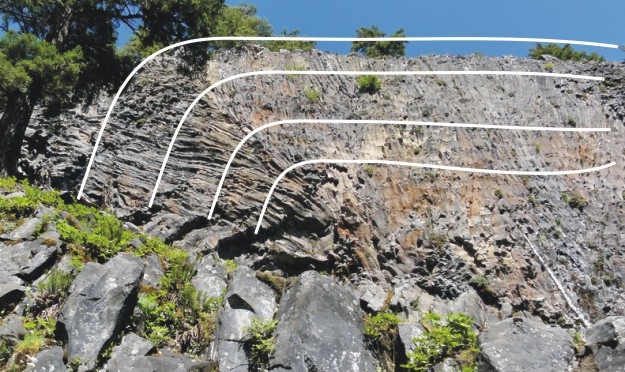
These lines represent the successive stages of the cooling front as it propagates through the lava deposit. If it cooled from the top down (typical but not required), then perhaps it reflects a sequence of cooling front positions like this:
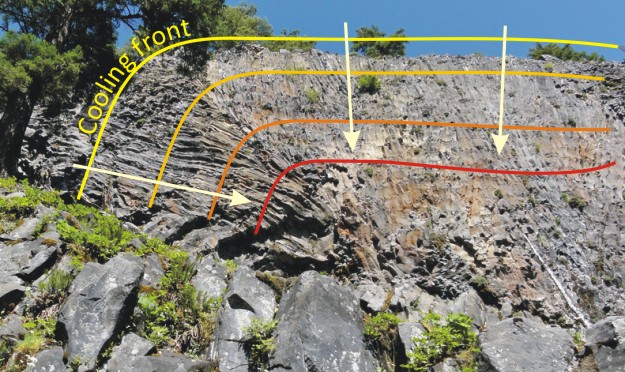
Okay, great: so now we’ve mapped out the shape of the cooling front as the lava crystallized into cold andesite. But why does it have that non-planar shape?
A couple of possibilities occur to me.
One is that there was a big heat sink next door – perhaps some glacial ice, which caused the edge of the lava flow to cool more rapidly that the center of the flow (further to the right):
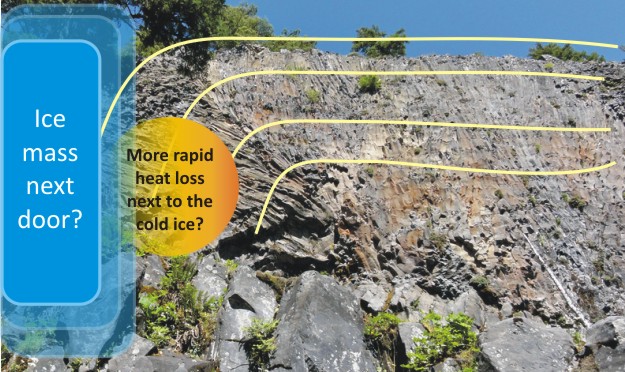
Another possibility is that an extra heat source from below perturbed the cooling front upwards, perhaps by funneling steam through a vent (a fumarole) to the surface, keeping the rocks warmer than they might otherwise have been:
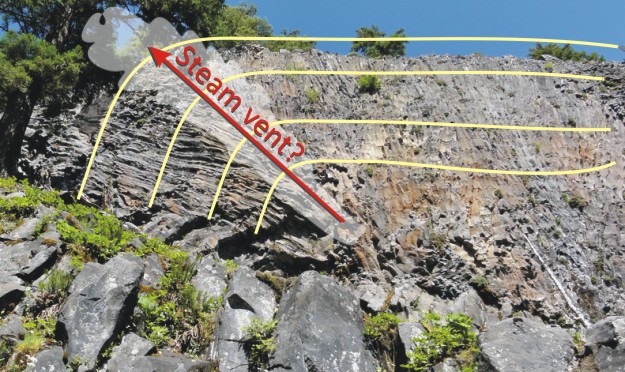
Here’s an example of the latter, a fumarole-related column complex from the Bishop Tuff of eastern California’s volcanic tableland:
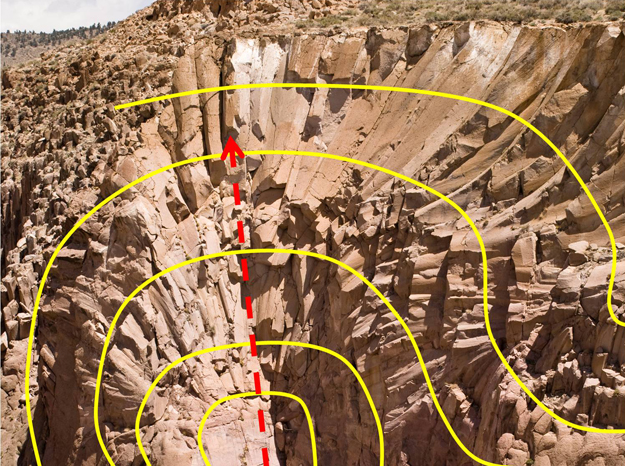
The red arrow represents the steam flow pathway; the yellow lines are traces of the isothermic cooling front over time.
Now, consider another well known example of columnar jointing, Devils Tower of Wyoming:

Notice how the columns flare out at the base?
That implies a cooling front with a shape that is concave-up:
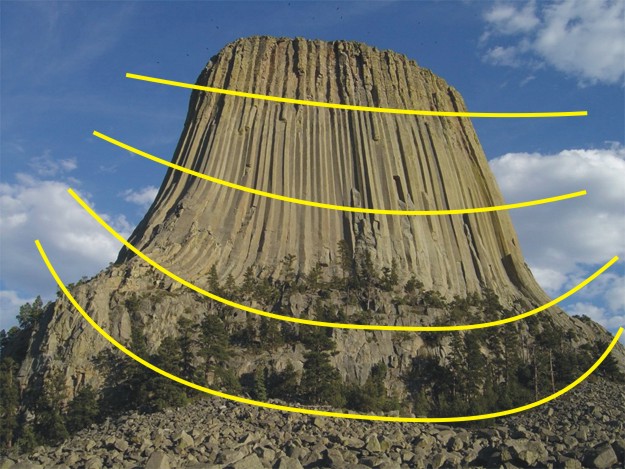
A lot of people look at the shape of Devils Tower and infer it to be a volcanic neck (akin to Shiprock, in New Mexico). However, the pattern of columnar jointing is totally wrong for a volcanic neck. Think about it: a cylindrical mass of warm rock in the throat of a volcano would look something like this:
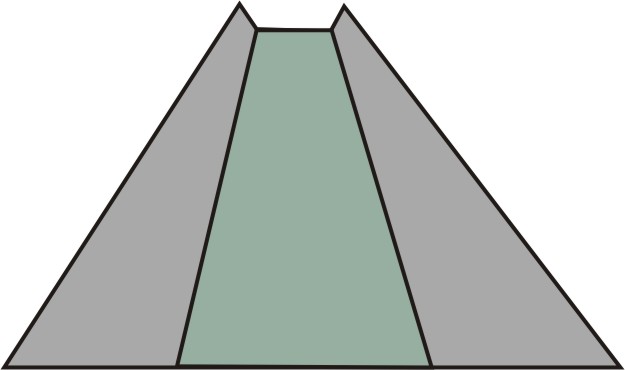
Which would produce a cooling front that looks something like this:
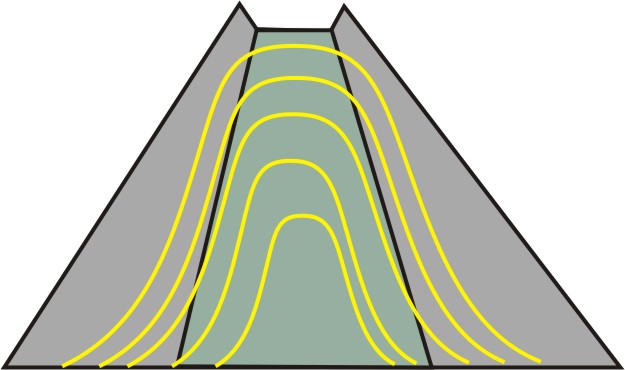
Which would result in columns that radiated outward, like so:

That’s the opposite of what we see at Devils Tower – the larger context of that intrusion must be something like this:

Of course, then subsequent weathering would have removed the outermost parts of the upper portion of the intrusion, to result in the iconic landmark we see today.
So where does that leave us in interpreting Dana’s photo?
It occurs to me that perhaps what we have is a lava flow with a shape that loses heat more rapidly in thin parts, and loses heat more slowly in the thickest bits. Perhaps the lava flow filled an ancient valley, and so has a semi-circular shape in cross-section, which results in faster cooling on the thin edge, and slower cooling in the middle. The resulting fracture pattern could yield the columnar array that Dana photographed, like so:
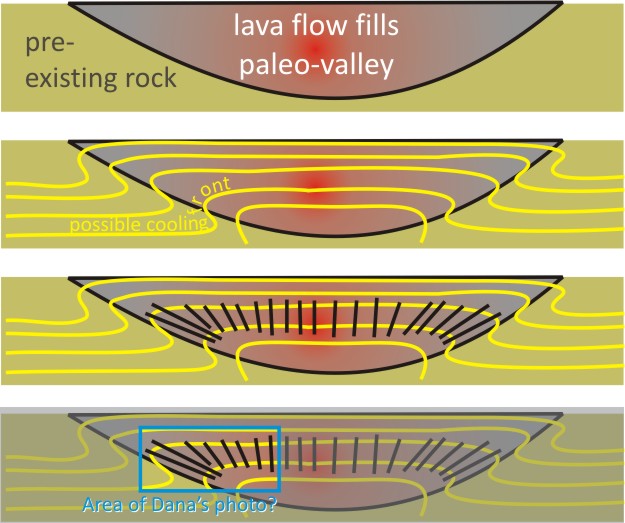
If I were at the outcrop in person, I’d check around for other exposures, and get a sense of the three-dimensional range of column orientations as a way of testing this hypothesis.
Anyone else have other ideas?


 Callan Bentley is Associate Professor of Geology at Piedmont Virginia Community College in Charlottesville, Virginia. He is a Fellow of the Geological Society of America. For his work on this blog, the National Association of Geoscience Teachers recognized him with the James Shea Award. He has also won the Outstanding Faculty Award from the State Council on Higher Education in Virginia, and the Biggs Award for Excellence in Geoscience Teaching from the Geoscience Education Division of the Geological Society of America. In previous years, Callan served as a contributing editor at EARTH magazine, President of the Geological Society of Washington and President the Geo2YC division of NAGT.
Callan Bentley is Associate Professor of Geology at Piedmont Virginia Community College in Charlottesville, Virginia. He is a Fellow of the Geological Society of America. For his work on this blog, the National Association of Geoscience Teachers recognized him with the James Shea Award. He has also won the Outstanding Faculty Award from the State Council on Higher Education in Virginia, and the Biggs Award for Excellence in Geoscience Teaching from the Geoscience Education Division of the Geological Society of America. In previous years, Callan served as a contributing editor at EARTH magazine, President of the Geological Society of Washington and President the Geo2YC division of NAGT.
This is the first time cooling fronts have ever even begun to make sense. I’m horrible at visualizations of this type, alas – having it sketched out gives my mind an edge to grab on to. A new tool in the mental toolkit. Huzzah! I wanna go look at lots and lots of columns now…
Thank you!
🙂
You’re welcome!
Thanks for all the illustrations, very useful. I am skeptical about the ice block/glacier possibility simply because I can’t recall an example. It would seem to me that a difference of 25 or 30 degrees C between the ice and air or ground wouldn’t be that significant. I would think the thermal diffusivity difference between rock and (what will surely soon melt to become) a free surface would be more important. Just some musings.
Dang, that Bishop Tuff vent is wonderful.
The mechanism is as figure shown:
http://www.columbia.edu/itc/ldeo/v1011x-1/jcm/Topic3/Image1b.gif
http://3.bp.blogspot.com/_Z_eA9h6Oj6w/TL2Rc6lXOdI/AAAAAAAAA0s/SUvkLN51_k4/s1600/image.jpg
http://2.bp.blogspot.com/_Z_eA9h6Oj6w/TL2O3bcpNoI/AAAAAAAAA0k/mbjZ_AaJK58/s1600/giants-causeway.jpg
I’d like to better understand your discussion of Devil’s Tower. I would have thought that the outer structure of the volcano would have provided the insulation on the sides with the heat loss taking place at the crater. What is the alternate mechanism you are proposing for how the Devil’s Tower was formed?
(Sorry — “proposing” implies that I have any idea what I’m talking about. I should have said “describing” above. My bad.)
“Some” insulation, sure. But in comparison to the Earth below, probably not enough insulation. The pattern of columns does not agree with the volcanic neck hypothesis. It better matches a concave-up-shaped cooling front.
Very useful and interesting post. Thank you.
In Hong Kong, we have got some “kink-bands” in the cooling columns, and used to interpret them as a product of kink-folding. Well, I now start to think that we may need to re-consider these features.
So, is Devil’s Tower possibly part of a larger flow that’s been eroded? Contrary to popular sentiment?
Part of a larger intrusion (shallow), I would say, not a flow. But the edges have been eroded away, yes, almost certainly.
[…] was inspired by Callan’s interesting post last week on the patterns of some cooling columns. Callan has explained, using some nice […]
Couple of nice blog posts about columnar jointing in Washington here:http://bit.ly/oJATXp and http://bit.ly/qjd9Up
[…] on page 88, where he claims basalt columns “are always formed vertical.” Nope – they form perpendicular to the cooling front, which is not always going to leave them oriented vertically. This would confuse the heck out of […]